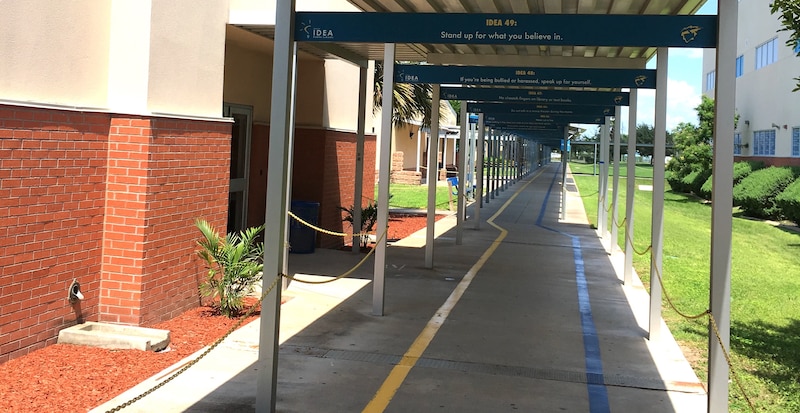It’s been 20 years since teachers Tom Torkelson and JoAnn Gama founded an after-school program in Donna, Texas, a city of about 16,000 along the U.S.-Mexico border.
By 2000, Torkelson and Gama had turned the program into a charter school with a light bulb logo. They named it “Individuals Dedicated to Excellence and Achievement.”
Now, it’s just known as IDEA, and is a network of 79 schools. Portable classrooms remain on that Donna campus, with “WHATEVER IT TAKES” and “CLOSING THE ACHIEVEMENT GAP” on signs in the windows — reminders, educators said during a recent tour, of the network’s origins. But IDEA’s roots are now spreading even further beyond the dusty Texas terrain where it was founded.
The campus in Donna is the flagship of a network poised to become the second largest nonprofit charter network in the U.S. this year. IDEA already serves 45,000 students, mostly in the Austin, San Antonio, and El Paso areas, and it’s moving fast, starting 18 schools this fall alone. Four opened in Baton Rouge, Louisiana, the network’s first foray outside Texas.
IDEA is also planning schools for New Orleans and Tampa, Florida, and its leaders have had talks with state officials in New Mexico. It’s making deeper inroads into the Lone Star State, too, including competitive areas like Houston and Dallas-Fort Worth. In four years, the network hopes to have 100,000 students in 173 schools.
But Torkelson told Chalkbeat his big-picture goal is even larger: in 10 years, IDEA wants to reach 250,000 students, putting it on par with some of the country’s largest school districts.
To get there, the network is looking at cities across the country where they think IDEA could succeed, including Cincinnati, Ohio. Sixty principals-in-training are already on staff, he said.
“The need piece is obviously easy — almost every urban area in the U.S. needs better schools,” Torkelson said. Now, they’re looking for outside support. “Our whole thing is, this is who we are. Let’s find people who like who we are.”
Big ambitions are nothing new for charter school networks. But this is an expansion worth watching, as IDEA tries to export the model it forged by teaching mostly Latino students near the border to very different communities — at a pace that few, if any, others are looking to match.
Nationally, that kind of growth is “more the exception,” said Todd Ziebarth of the National Alliance for Public Charter Schools. “It’s challenging enough to do it even if you’re just trying to open another school nearby or within the same state.”
That pace of growth raises lots of questions, he said: How will you fund the schools? Staff them all? Handle regulations in new states?
Some networks with “radical” growth plans have faltered, he noted, pointing to the Rocketship charter schools. But IDEA’s steady, deliberate growth to this point and the schools’ results for low-income students of color may put it on steadier footing, he said.
Indeed, IDEA has a track record of doing well with students who often struggle. Nearly 90 percent of IDEA’s students qualify for free or reduced-price lunch, and most are students of color living in historically Latino-dominant communities. A national study of charter networks found IDEA was among those that had a positive impact on student learning.
According to a recent analysis by the Dallas Morning News, 29 of 56 eligible IDEA campuses would have earned an A under Texas’s new A-F accountability system. That’s one of the highest rates of any school system in the state. (The state did not release campus grades this year; the News calculated those ratings using available data.) IDEA also says 58 percent of graduates earn a diploma in six years from a four-year college.
Who, exactly, those graduates are is a topic of contention, especially among leaders of local school districts. IDEA’s schools enroll students through a lottery, but some students with past criminal or disciplinary records can be excluded.
“We don’t have a choice as to who comes to our doors,” said René Gutiérrez, superintendent of the Edinburg school district, where IDEA has three campuses.
Once students arrive, a sizeable chunk also leave IDEA within four years — at one point, at least one-third of students did. The schools’ share of students with disabilities is low, too: 4.8 percent in 2016-17. Texas’ statewide rate was 8.8 percent that year, and the state’s rates have been low enough to spark a federal investigation. (Torkelson says the network’s teaching practices allow students to avoid being labeled; the network did not provide updated numbers on students who leave.)
The network leans into its “no excuses” motto — it’s even on their uniforms. Discipline is strict, school days are somewhat long, and students are required to apply to a college and get accepted to earn their high school diploma.
And as other no-excuses networks have tried to add more wiggle room to the “college for all” idea, IDEA has held firm. “If you don’t believe that every student should go to college, you don’t belong,” Ernesto Cantu, head of IDEA’s El Paso office, said earlier this year.
But IDEA has been able to avoid some of the criticism that has dogged other no-excuses schools because observers also say IDEA is unusually culturally competent. The schools’ suspension numbers are low, and the network’s teaching staff is 85 percent non-white. Counselors at the Donna campus said in the days after the 2016 presidential election, leaders spent time reassuring students and staff that the school would help them navigate any immigration policy changes and acknowledged the growing amount of racist rhetoric about Latinos that students were encountering.
As IDEA started serving more black students in schools north of the Rio Grande Valley, and after high-profile shootings in 2016 left both police officers and unarmed young black men dead, Gama and other school leaders lamented the deaths on Facebook using the Black Lives Matter hashtag. Some parents complained the posts were anti-police and even threatened to withdraw their kids in protest, according to Texas media reports. But IDEA reiterated its support, saying it sent an important message to their black students.
“This was a school I tried to recruit a decade ago to come into Louisiana when I was working in the state department of education there,” said Chris Meyer, now the CEO of the pro-school-choice organization New Schools for Baton Rouge, where IDEA serves a largely black student population and plans to open more schools. “They seem to know their DNA well.”

That sense of identity has already been tested as the network moved out of its base in the Valley.
When IDEA first expanded into Austin in 2011, the network took over a low-scoring campus in the local school district. Community activists mobilized, the backlash sent people to the polls, the school board’s membership changed, and the partnership offer was rescinded the following year. IDEA failed to build local relationships, Torkelson acknowledges.
“We should’ve known better,” he said. “It was naïve and it was foolish and we got clobbered.”
As IDEA’s initial foray into Austin was imploding, the charter won crucial support in San Antonio from David Robinson, the locally beloved NBA champion. He handed IDEA the keys to Carver Academy, a school he had helped create, and smoothed over relations in that community.
IDEA went on to open its own campus in Austin. It now has 10 schools there, and thanks to a $16 million boost from the Austin-based KLE Foundation, IDEA’s plans are to reach 26 schools in the Austin area by 2022, serving as many as 20,000 students.
Those experiences have led IDEA to its current playbook — one that more communities are likely to see up close in the years ahead.
The network’s leaders say they do a better job of finding trusted local advocates. Torkelson said the reason they are headed to Louisiana and Tampa Bay, Florida is because leaders have welcomed them. In Florida, Torkelson said State Rep. Michael Bileca — who pushed for that state’s new “Schools of Hope” program, which encourages charter schools to open near struggling district schools — reached out to IDEA several years ago.
Another factor: money. Last year, IDEA launched a fundraising campaign of $250 million to help fund its growth. It won $67 million from the federal government last year as well; a document it filed then indicates it had raised nearly $75 million from the state of Texas and a number of foundations. The organization’s goal has since been upped to $350 million.
That money allows IDEA to spend on facilities and teacher training before opening a campus and hire salaried administrators months and sometimes years in advance.
“It’s no coincidence I’m on the ground 18 months before the schools launch,” Ana Martinez, who is leading IDEA’s expansion into the Fort Worth area, told Education Post earlier this year.
Research has shown that high-performing charter schools can scale without losing their effectiveness by closely emulating the original schools’ practices. In that sense, IDEA appears to have well-laid plans.
“I have been hired to bake an IDEA cake,” Martinez said. “There are things that always go in the cake, whether I bake it in Baton Rouge or Fort Worth: the sugar, the eggs, the flour. I won’t negotiate the eggs, the flour and the sugar but I have autonomy for everything else.”
Still, scaling fast comes with risks. KIPP, which Torkelson has called a “close cousin,” remains the country’s biggest nonprofit network and is still expanding rapidly: its enrollment goal by 2020 represents doubling the number of students served in about five years, a KIPP spokesman said. But many other networks have decided against opening more than a couple of schools per year because of concerns about maintaining quality.
“KIPP is really one of the only successful networks doing what IDEA is doing on a larger scale,” Ziebarth said.
Robin Lake of the Center for Reinventing Public Education, which is generally supportive of charters, said that rapidly growing systems can also start to face the same bureaucratic challenges that larger traditional public school districts do. There are also signs that it will be harder to mount this expansion now than it might have been a decade ago. National polls show that charters have become increasingly synonymous with the Republican political agenda, which is itself unpopular among the key places IDEA plans to go.
“The conversation around charter and private schools is more politicized than it used to be, and is a chief dynamic that has had an impact in urban areas, which tend to be more liberal and where charters are most active,” Lake said.
Many school districts are also beginning to really feel the pain of falling enrollment as networks like IDEA siphon anywhere from 5, 10, or even 20 percent of their students. That could provoke backlash against IDEA’s expansion, Lake said.
The network’s national plans beyond Louisiana remain a few years off. In the shorter term, though, IDEA’s biggest battles may happen in its own home state.
Already, if you drive from San Antonio to Austin, you’ll see a billboard alongside Interstate 35 touting IDEA’s new campus in Kyle, a growing town outside of Austin. And along the main highway into and out of the Valley, you’ll encounter a billboard by the Edinburg Consolidated Independent School District touting its “A” ratings. That district has seen enrollment fall by several hundred students in the last five years.
“We each just go about own business, and we just focus on ourselves and, for me personally, on what I can do and what I can control,” said Gutiérrez, the Edinburg superintendent. “I think we try to better ourselves every year regardless if there are charter schools or not.”


